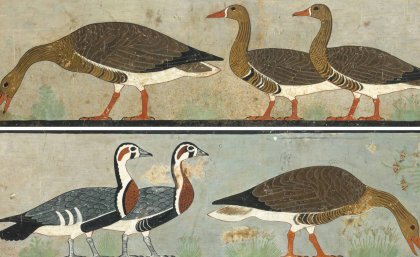
Image above: ‘Meidum Ganzen’, Chapel of Itet, mastaba of Nefermaat and Itet (Dynasty 4), Meidum, Egypt. Credit: CK Wilkinson
When a University of Queensland researcher examined a 4,600-year-old Egyptian painting last year, a spotted goose caught his eye.
UQ scientist, dr. Anthony Romilio, said that the strange but beautiful bird was completely different from modern red-breasted geese (Branta ruficollis), with clear, bold colors and patterns on its body, face, chest, wings and legs.
“The painting, Meidum Geese, has been admired since its discovery in the 1800s and is described as ‘Egyptian Mona Lisa,'” he said.
“Nobody seemed to realize that it was an unknown species.
“Artistic licenses may explain the differences with modern geese, but artwork from this site has extremely realistic representations of other birds and mammals.”
Dr Romilio said no bones of modern red-breasted geese (Branta ruficollis) had been found at any Egyptian archaeological site.
“Oddly enough, bones of a similar but not identical bird were found on Crete,” he said.
“From a zoological perspective, the Egyptian artwork is the only documentation of this distinctive goose, which has apparently now become extinct worldwide.”
Dr. Romilio said extinct animals were identified earlier in ancient art, but not all species have been scientifically confirmed.
“I applied the Tobias criteria to the goose, along with other types of geese in the fresco,” he said.

Credit: CK Wilkinson
“It is an extremely effective method of identifying species – using quantitative measurements of key bird characteristics – and it reinforces the value of the information for zoological and ecological science.”
Dr Romilio said Egypt was not always predominantly desert and had a biodiverse history, rich in extinct species. ‘
“Ancient culture originated when the Sahara was green and covered with grasslands, lakes and woodland, full of different animals, many of which were depicted in tombs and temples,” he said.
“So far, science has confirmed the identity of relatively few of these species.”
Dr Romilio said the artwork he examined was from the tomb of Nefermaat and Itet at Meidum and is now in Cairo’s Museum of Egyptian Antiquities.
“Art provides cultural insight, but also a valuable, graphic account of animals that is still unknown today,” he said.
“This includes the predecessor of modern cattle, the auroch (Bos primigenius), and previously unknown forms of gazelles, oryx, antelope and donkeys.
‘These ancient animal representations help us to recognize the biodiversity that existed with humans thousands of years ago.
“I also see it as a reminder of the influence of humans on the survival of species that are with us today.”
The research was published in the Journal of Archaeological Science: Reports.
Dr Romilio said that a multitude of species with color markings that did not match those of modern animals were set out in a guide to extinct animals in ancient Egypt.
‘Dino Cave’ reveals dinosaur walkers
A. Romilio. Assessment of ‘Meidum Geese’ species identification with the ‘Tobias criteria’, Journal of Archaeological Science: Reports (2021). DOI: 10.1016 / j.jasrep.2021.102834
Provided by the University of Queensland
Quotation: Ancient Art Reveals Extinct Goose (2021, February 23) Retrieved February 24, 2021 from https://phys.org/news/2021-02-ancient-art-reveals-extinct-goose.html
This document is subject to copyright. Except for any fair trade for the purpose of private study or research, no portion may be reproduced without the written permission. The content is provided for informational purposes only.
